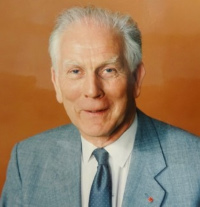About FIG

|
Dr Arthur L Allan: My FIG Journey
Dr Arthur L Allan is FIG Honorary Member and has
written this FIG story in 2020 at the age of 90 on his experiences in
FIG.
Preamble
“Dr Allan, I want you to meet Pietro Alaria’. There before me
stood a short middle-aged man clutching a large book. I was in Italy
to make my study. It was explained to me that here was the surveyor
who had observed every triangulation station of the Italian network
used to drive the Mont Blanc tunnel. Because he had a serious
accident, he was unable to complete the task, leaving one
triangulation station for another to observe. His and the French
surveys were so accurate that the tunnel holed out by 13 cm over a
distance of 11.611 km (7.215 miles). Drilling began in 1959 and was
completed in 1962. Alaria was typical of the calibre of many
surveyors whom I was privileged to meet during my long 20-year FIG
journey. Such fellowship was a major, if not the reason for my
involvement.
The International Federation of Surveyors or F.I.G
The profession of Land and Geodetic Surveying, or Geomatics as it is
called these days, has always been global in its operation and
scientific basis from the beginning of civilisation. As a young
surveyor, I spent most if my field experience in Africa and the
Caribbean, making astronomical observations, triangulation work and
so on. Because survey organisations, private and government, employ
staff trained in various parts of the world, and specifications are
set by international experts, it is no wonder that I was interested
in the F.I.G and saw it as an organisation worth supporting, and
perhaps contributing to its development. My first task was to learn
F.I.G speak. To be specific, always say “Eff Eye Gee”, because “fig”
is a naughty word in German! Also learn to speak slowly for the
benefit of translators.
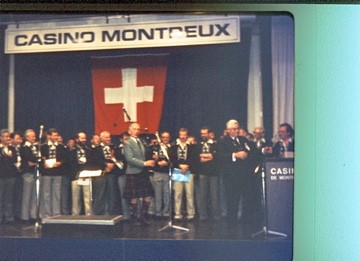
Allan piping with the Swiss Surveyors' Choir and Dutchler (also
former Honorary Member of FIG) playing his Alpenhorn 1981
International Education and Practice
When In 1968, it was the UK’s turn to host the large conference of
FIG in London, and as part of the build-up, Robert Steel
(Secretary General of the RICS), asked John Hollwey and me
respectively to prepare two booklets to be used to underpin the
discussions in Commissions One (Professional Practice), and Two
(Education), I accepted the opportunity without hesitation. As a
teacher of professional surveyors, It was and is vital to keep up to
date in a rapidly changing world. In my time we have moved from
plane tables to GPS; from logarithms and slide rules to blue tooth
and micro-processors; from copper plates to computer graphics; and
especially from local spheroids to World Geodetic Systems.
The FIG booklets of 1968 had several objectives. Firstly they would
enrich conference efficiency by allowing more discussion and avoid
time-wasting with pure fact giving: secondly they would help to
create world-wide standard benchmarks in education and
practice ; and thirdly they would be of great assistance to
employers, when hiring foreign staff.
Because I had very little idea how to tackle this assignment, I
sought advice from Professor J A Lauwerys at the London University
Institute of Education. In a three-hour long meeting one evening, he
gave me much valuable advice. A key factor was to stress the need
for feedback of my interim findings to the country’s
representatives, before leaving the country after any fact-finding
visit. This proved essential advice, giving an opportunity to iron
out salient misconceptions; often on my part. I was to take this
advice in later European studies, when I made such visits.
He also guided me towards the UNESCO publications of comparative
education studies, so that my presentations would be consistent with
standard practice.
For the 1968 study, I compiled a questionnaire which was sent to all
FIG member associations. From the answers I was able to publish
the basic educational structure of 27 countries, and detailed
information for 16. The result was the booklet “Education for the
Profession” published by the RICS. A later much revised version was
published by the FIG. in 1974, with details of 34
member-associations. Of course, these required input from many
persons across the Globe.
Following the success of these booklets, I was asked by the CLGE
(Comite de Liaison des Geometres Experts) to make a more detailed
analysis of the education and practice of geodetic surveyors in
Western Europe; this was to prepare the way for mutual recognition
of the professions across the EU. Over a few years I visited all 17
countries, hosted by each association with travel aid by the RICS.
It was a most interesting experience, leading to the publication by
the FIG of an extensive text in 1995. The schedule I followed,
usually over four days, included visits to a Technical College, a
University, a private professional practice and sometimes a
government department. Each evening I wrote a draft report often
kindly interrupted by gastronomic interludes late in the evening.
The final stage was to present this draft to a meeting of the board
of the national association and benefit hugely from an exchange of
opinions. This was essential for mutual understanding and
clarification. In a few cases I had to publish two alternative
judgements.
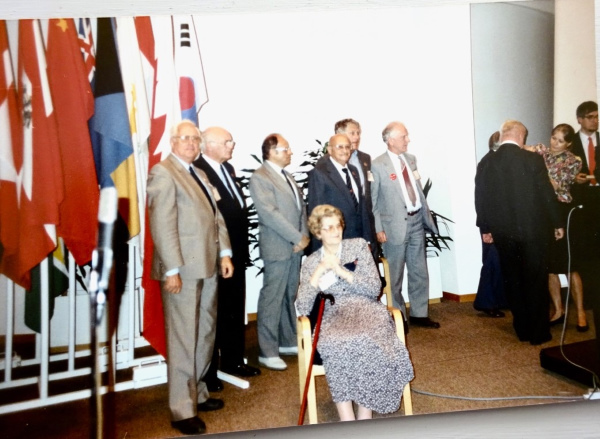
Membres d'Honneur
Quality Control in Education
To my mind the analysis had to be made by one person alone, so that
some measure of consistency could be assured, especially in the
matter of scope and standards of knowledge, and as far as is humanly
possible, a measure impartiality could be maintained. I had and
still have no concept of “the best system of education and
practice”. For example, in Europe we have two adjacent countries,
Switzerland and Italy, with entirely different systems of education
and practice. And yet each serves the country well. As the saying
goes, “There are many ways of killing a cat”.
In some countries I became aware of much duplication of syllabuses
and curriculum inertia, often spread over three separate competing
departments. This is in contrast to UK where staff are continually
modernising course content in response to the rapid changes in
technology. A classic example was one establishment which had three
professors of classical field astronomy; a subject which was
obsolete in the satellite age. An almost complete lack of any system
of quality control characterised some education departments.
Anything like the UK external examiner system was almost unknown.
However, the final quality of the education was everywhere carefully
monitored by the respective professional institutions during the
stagiare stage of two or more years. I was very impressed by the
function and quality of many laboratories, for example the Winter
Garden in Finland, which I copied at my technical college, UCL, and
the University of Trinidad, when I was consulted to propose a
brand new department of Land Surveying, including its building.
specification. This was subsequently built and the Department
established.
Commission Two Activities
Following Hans Klinkenberg’s initial guidance, when I became
Chairman, I set about trying to make the Conference sessions as
effective as possible, by the strict use of the background booklets,
and by organising visits to at least one education establishment.
From the Montreux Conference, the first of these was to the
Ingeneurschule at Yverdon. The outcome was more fruitful that we
could have imagined; delegates opened up when in small groups to
discuss issues stimulated by the exhibits of student work on show.
Subsequently we visited the Universities of Glasgow and Madrid with
equal success.
Because one of my pet enthusiasms is the use of visual aids in
teaching, much to the amusement of the audience, I presented a paper
in Washington exhibiting a black umbrella functioning as a portable
planetarium. I believe a teacher should do as much as possible to
help students, not show off his own erudition. Over the years these
exchanges of ideas brings about a gradual process of evolution
and a maintenance of high standards across the world.
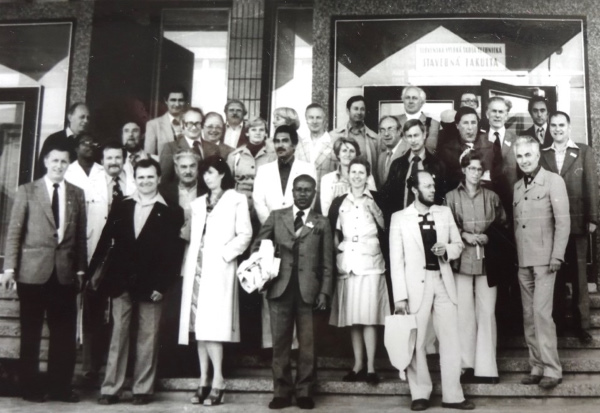
Commission Two at Brno 1979
External Examining
It falls annually to senior academics in the UK to act as external
examiner of final year course standards at institutions other than
one’s own. This entails vetting the draft examination papers and
during a visit, the inspection of course-work and spot interviews of
borderline students, especially where a first-class degree is in
question. Throughout my career I made such trips to the following
universities; Nottingham, Newcastle, Nairobi, Dar e salaam,
Trinidad, Harare, and Nsukka (Nigeria). I also carried out a similar
function at the School of Military Survey Newbury.
It was not all Work
As a happy diversion from the work of the commissions and viewing
the instrument exhibitions, each host usually provided some form of
entertainment. Many of these have fond places my memory. For the
record I will mention but a few from each venue I attended.
- 1968 London Congress. I begin in the London Guidhall, enthralled by
the skirl of Scottish pipers, magnificently arrayed in kilts, while
conversing in French with a Czech professor, as we admire a superb
array of antique timepieces.
- 1971 Wiesbaden Congress. Moving to Germany, who could be other than
enchanted by the sweet tones of Boys Choir in a Wiesbaden Monastery,
and afterwards enjoying tasting the various wines on offer?
- 1972 Israel PC Meeting. Israel was next on the bill, providing
access to private homes during the Sabbath, and the opportunity to
visit the biblical lands and the fortress of Masada.
- 1974 Washington Congress. Surely no-one who gazed in silence at the
thousands of gravestones at the Gettysburg cemetery could return
home unaffected; nor chuckle at the crowd antics at the American
Football match.
- 1977 Stockholm Congress. As for a Sunday barbecue, in Stockholm, for
fifty or so former Scout leaders who ended the afternoon with a
traditional Campfire led by a slightly inebriated Dane, there can
only be praise and thanks.
- 1978 Sophia PC Meeting. If you joined us in the Alexander Nevsky
Cathedral in Sofia at 7am to hear four male singers exploit its huge
echo and raise an eight-part harmony motet you experienced a moment
of deep introspection. Perhaps this was only bettered by the visit
to the glorious Rila Monastery.
- 1979 Brno Congress. Then again, how well the Czechs have preserved
the site of the Battle of Austerlitz is a wonder to behold. At the
meeting in Brno, we also enjoyed a production of Smetana’s Battered
Bride, and engaged in lusty redition of La Marsellaise one
late evening in Bratislava.
- !979 Paris PC Meeting. How disappointed we were not to have dinner
in the Hall of Mirrors at Versailles as planned by our French
colleagues. Marie Antoinette’s prison surely was an equally historic
alternative.
- 1980 Edinburgh PC Meeting. The high point was for me to pipe Alec
Douglas Hume, a former U.K. Prime Minister, on to a platform to open
the PC. Meeting. Following the example of Israel, evening visits to
the homes of Chartered Surveyors proved a success., and a trip round
the dungeons of Edinburgh Castle was quite fascinating.
- 1981 Montreux Congress. My bagpipes were featured again in Montreux,
along with Mr Duchler and his Alpenhorn, and the Swiss Surveyors’
Choir, which was formed specially for the Congress.
- 1984 Tokyo Congress. By contrast, the Japanese had laid on a visit
to a Geisha Ceremony. No guesses as to who was selected to act the
male part!
- 1986 Toronto Congress. A taste of the sport of Curling and
attendance at an historic battle re-enactment spiced the Toronto
meeting. Here the visitors were delighted by the final ceremony
featuring the City of Toronto World class pipe-band and a rather
amusing Japanese lady photographer.
- 1990 Helsinki Congress. To cap off the account, nothing could rival
the mid-night golf match in Finland, when eighteen of us lost 58
balls, before enjoying a tasty al-fresco meal.
So, you see it was not all work.
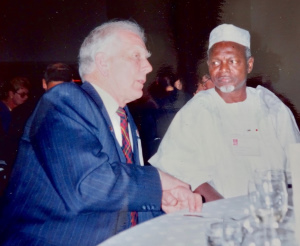
Helsinki 1990 Alland and Chief Ojekere (Nigeria) |
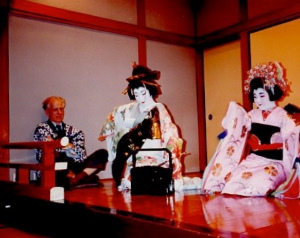
Cultural visit Japan 1984; Allan meets the Geishas |
The benefits of FIG involvement
To describe some of the benefits accruing from involvement in FIG,
we must consider two aspects; (1) Benefits to the profession at home
and abroad. (2) Personal benefits. To some extend these are not
mutually exclusive, because any improvement in the profession
benefits all members. FIG has been able to lobby governments and
international institutions to ensure that its members are well known
and valued. Some politicians have no idea of the importance of basic
up to date mapping, nor of ownership guarantees, nor of the need to
operate spatial data efficiently. As I mentioned above, educational
and professional competence data is of great help to employers and
clients. Also Congresses and instrument exhibitions give users and
manufacturers and universities the necessary opportunity to exchange
knowledge. On a personal basis, the meeting of life-long friends
ranks high in a scale of benefits. It has been a marvellous journey
for me.
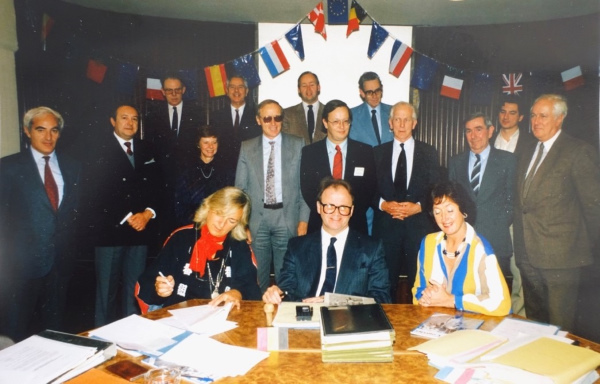
Brussels CLGE 1985
Postscript
It has always been clear to me that all this activity could not
happen without the dedication of many unknown administrators who
made all the arrangements for travel and general backup. In my case
I think of Robert Steel, Rosemary Rowles and Jane Woolley of the
RICS. Words cannot express my thanks to them sufficiently, nor to
all the many persons in various countries who performed such tasks
on my behalf. I have also been very fortunate to have had the
companionship of Jim Smith and his wife Ann, for many of these
visits, and many others from time to time. Yes indeed: it has been a
wonderful journey.

UK delegates at Budapest 1989
Arthur Allan (age 90) ; Membre d’Honneur FIG. Bristol 2020.
|
























